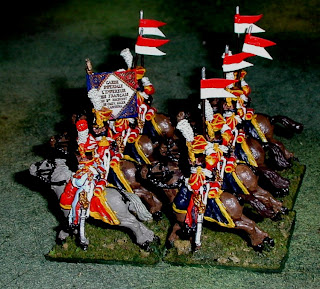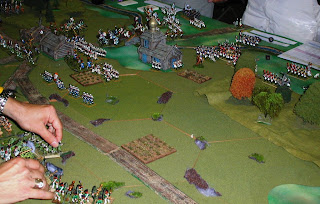After I come back from Historicon each year, unpacking and reorganizing my stuff is usually a project I take a month or so to get around to. This year was no exception. However, I decided to use that to my advantage and "upgrade" my veteran French Line and Legere units with a coat of Magic Wash, and take some pictures along the way.
I generally have my French Infantry organized into "Divisions" of 4 Ligne and 1 Legere "Regiment", each of 18 figures, which makes 1 Grenadier, 1 Voltigeur, and 4 Fusilier companies, neatly mimicing the post 1808 organization. Of course this is the Battalion organization and I'm calling them Regiments, but no matter! :-). I usually try to have the Division modeled on a historical one, preferably based upon the 1809 campaign. There's nothing really necessary about that, nor does it have any impact upon their table top ratings... I just like it that way.
When I finally decided to abandon the 33 battalions of Line and 9 of Legere (Scruby 25mm) that had served me so valiantly for almost three decades, I decided to redo my French with Wargames Foundry figures, and bought the whole thing at once (this was just before their prices lost contact with reality). Just as in my original Scruby army, the plan was to have the component "Regiments" of each "Division" all be in the same pose. The individual Regiments, as I have described before in Part 1, 2 and 4, would use the Fusilier company pom pom color (Green, Sky Blue, Violet or Aurore) as Regimental differentiation, that is to say, the first regiment of the Division having ALL of the fusilier stands with Sky Blue pompoms, the second with ALL green, etc. Of course, having 4 units in the same poise, if desired, the companies could easily be reshuffled to make each unit have the four Fusilier companies have the proper mix of the four colors... tricky, eh?!
Foundy had four poses of French Ligne in the 1809 uniform, so 4 such Divisions were planned, purchased, and in fairly rapid order, painted. I have since added three more such Divisions, one of Sash and Saber figures, one of Old Glory, and the last of Old Glory figures in Overcoats. You can never have too much French Line Infantry, right? RIGHT?! Still, these original guys have been the true "Old Guard" (if you will), of my "new" French Napoleonic wargames army. So, as I "enhance" them a bit with the wash, they'll also get some time in the sun here on the blog!
I generally have my French Infantry organized into "Divisions" of 4 Ligne and 1 Legere "Regiment", each of 18 figures, which makes 1 Grenadier, 1 Voltigeur, and 4 Fusilier companies, neatly mimicing the post 1808 organization. Of course this is the Battalion organization and I'm calling them Regiments, but no matter! :-). I usually try to have the Division modeled on a historical one, preferably based upon the 1809 campaign. There's nothing really necessary about that, nor does it have any impact upon their table top ratings... I just like it that way.
When I finally decided to abandon the 33 battalions of Line and 9 of Legere (Scruby 25mm) that had served me so valiantly for almost three decades, I decided to redo my French with Wargames Foundry figures, and bought the whole thing at once (this was just before their prices lost contact with reality). Just as in my original Scruby army, the plan was to have the component "Regiments" of each "Division" all be in the same pose. The individual Regiments, as I have described before in Part 1, 2 and 4, would use the Fusilier company pom pom color (Green, Sky Blue, Violet or Aurore) as Regimental differentiation, that is to say, the first regiment of the Division having ALL of the fusilier stands with Sky Blue pompoms, the second with ALL green, etc. Of course, having 4 units in the same poise, if desired, the companies could easily be reshuffled to make each unit have the four Fusilier companies have the proper mix of the four colors... tricky, eh?!
Foundy had four poses of French Ligne in the 1809 uniform, so 4 such Divisions were planned, purchased, and in fairly rapid order, painted. I have since added three more such Divisions, one of Sash and Saber figures, one of Old Glory, and the last of Old Glory figures in Overcoats. You can never have too much French Line Infantry, right? RIGHT?! Still, these original guys have been the true "Old Guard" (if you will), of my "new" French Napoleonic wargames army. So, as I "enhance" them a bit with the wash, they'll also get some time in the sun here on the blog!
So, here they are, freshly unpacked from their Really Useful Boxes, 16 units of 18, 288 figures!
The side view demonstrates the four poses nicely - Marching, Advancing, Receiving, and Firing!
The next step was to use the "Magic Wash" on these figures en masse, a "Division" of 72 figures at a time. At the same time, I did a very little touch up work - painting the edges of some of the flags where I had missed that, painting the buff leather tops of the Officer's boots where I had missed that, but little else in terms of prep work.
Here's a close up of 2 units after the Magic Wash but before they are sprayed (again) with acrylic varnish.
Here are the same two units from behind. The Wash has picked out some of the detail of the straps, plumes, cords, as well as the creases in the white pants and vests without significantly dulling the figures, I think.
Here's a Group shot of my First Division. This is based upon St. Hilaire's Division during the 1809 campaign (St. Hilaire himself being killed at Aspern-Essling, after allegedly being promised his Marshal's Baton by Napoleon).
The units are in the "Advancing" pose. I have placed them side by side here, making a sort of "column of divisions", the classic French attack column, at 1:10 scale. Interestingly, the first wargames rules I used/wrote, back in the 1970's, were based upon Frappe! by Ray Johnson, which used 1:10 scale. If you imagine the formation being the same depth but TEN times as wide, you start to see how much our warames figures distort/exaggerate the depth of field formations!
A final, rear view. The units of this Division are: the 3e Ligne, which traces its lineage back to the Piemont Regiment of the Royalist army, raised in 1569, the 57e Ligne, which traces back to the Beauvoisis Regiment, raised in 1667 and legendary during the Napoleonic as "Le Terrible", among the finest of all the Line units, the 72e Ligne, derived from the Vexin Regiment raised in 1674, and the 102e Ligne, first raised in 1791.
My Third Division is modelled upon that of Gudin, and is here shown with its units deployed in Squares, as they might have been during the Battle of Auerstatdt in 1806. Although some wargamers don't care for the "Firing" pose, I am rather fond of it myself.
The component Regiments of this Division are the 12e Ligne, originating from the Auxerrois Regiment raised in 1692, the 21e Ligne, derived from the Guyenne Regiment raised in 1589, the 25e Ligne, tracing back to the Poitou Regiment of 161, and the 85e Ligne, based upon the Diesbach Regiment, raised in 1690.
As my table is still a mess until I finish unpacking, I have used a little photo editing, with dubious success, to block out some of the background clutter! I have painted the edges of the stands in a slightly different shade for each Division as well, as another aid to sorting the troops out after a hard fought battle!
Next up is my 2nd Division, based upon that of Friant in 1809. Here, the units are deployed in L'Ordre Mixte, with the center unit in line supported by a unit in column to each flank as well as one behind it in reserve.
The Regiments of this Division are in the "receiving" pose, perhaps preparing to repulse a charge by some Austrian cavalry?
A rear view of the formation. It's commander, Friant, ultimately went on to command the Old Guard Division in 1813, after spending nine years under Marshal Davout.
The component regiments are the 33e Ligne, derived from the Tourraine Regiment (1625), the 48e Ligne, formed from the Artois Regiment (1610), the 108e Ligne, based upon the Regiment de l' Isle de France (1772), and the 111e Ligne, first raised in 1793. These same (numbered) regiments were part of my Scruby army, and the 48e Ligne of that force was the unit that I could always rely upon to rout the enemy!
This is my 4th Division, based upon that of Carra St Cyr. It is deployed in columns of divisions in a "checkerboard" fashion, another classic French Napoleonic tactical disposition.
The component Regiments of the Division are the 2e Ligne, based upon the Provence Regiment (1776), the 4e Ligne, derived from the Blaisois Regiment (1776), the 18e Ligne, stemming from the Royal-Auvergne Regiment (1776), and the 46e Ligne, tracing its lineage back to the Bretagne Regiment (1644).
A final parting shot of the 4th Division, composed of Foundry figures in the so-called "march Attack" pose.
I'll conclude with some shots of the combined Cavalry of the Imperial Guard, as suggested by Ashenduke on TMP following my posts on same earlier this month:
(the size difference between the (Minifigs) Mamelukes and the rest of the (Foundry) Guard Cavalry is certainly apparent here!
Back to painting Grenz and Hungarian infantry...
Peter


























































